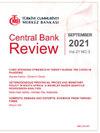Modeling and estimation of synchronization in size-sorted portfolio returns
Abstract
This paper examines the lead/lag relations between size-sorted portfolio returns through the lens of financial cycles governing these returns using a novel econometric methodology. Specifically, we develop a Markov-switching vector autoregressive model that allows for imperfect synchronization of cyclical regimes such as bull and bear market regimes in US large-, mid- and small-cap portfolio returns. This is achieved by characterizing the cycles of the mid- and small-cap portfolio returns in concordance with the cycle of large-cap portfolio returns together with potential phase shifts. We find that a three-regime model with distinct phase shifts across regimes characterizes the joint distribution of returns most adequately. These regimes are closely linked to the business cycle and small-cap portfolio returns are more sensitive to the cyclical phases than the large-cap portfolios. While all portfolios switch contemporaneously into boom and crash regimes, the large-cap portfolio leads the small-cap portfolio for switches to a moderate regime from a boom regime by a month. This suggests that small-cap portfolio adjusts with a delay to the relatively negative news compared to portfolios with larger market capitalization. We document that information diffusion accelerates in response to surprises related to the monetary policy. This reflects a link between financial returns and real economic activity from the viewpoint of ‘financial accelerator theory’ where portfolios with distinct size serve as a proxy for firm characteristics.

 求助内容:
求助内容: 应助结果提醒方式:
应助结果提醒方式:


